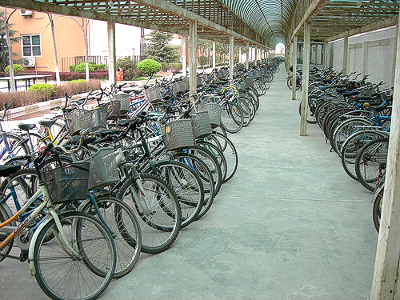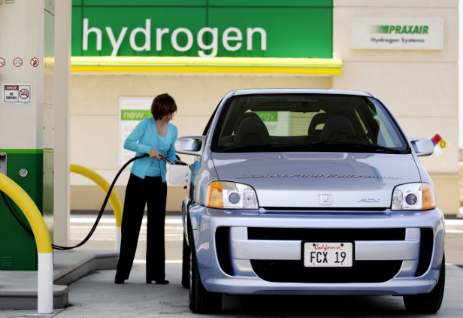 California is planning to invest millions to support the rollout of new hydrogen fueling stations. Pictured here is a station near Los Angeles Int’l Airport that was built by a partnership that included BP, Praxair and LAX.Courtesy Hydrogen Assn.
California is planning to invest millions to support the rollout of new hydrogen fueling stations. Pictured here is a station near Los Angeles Int’l Airport that was built by a partnership that included BP, Praxair and LAX.Courtesy Hydrogen Assn.
Energy Secretary Steven Chu may want to slam the brakes on future hydrogen funding, but California will continue to pay its own way down the Hydrogen Highway, infuriating electric vehicle advocates in particular.
Obama’s top energy official cut more than $100 million slated for hydrogen fuel-cell research from next year’s federal budget, arguing that in tough times, tough choices had to be made. His department will allocate nearly $800 million from the American Recovery and Reinvestment Act for advanced biofuels research and commercial-scale biorefinery projects, part of his area of expertise at Lawrence Berkeley National Laboratory before he joined the Obama administration.
In California, however, state lawmakers and regulators are handing out more money for hydrogen projects. Shell Oil, for example, will receive nearly $2 million in state funds to help build a hydrogen pump at a gas station near a swank Newport Beach country club and high end shopping mall. The pump will service a few dozen cars. State officials and hydrogen backers say it is a small but key step forward in solving the nation’s energy and environmental woes. An additional $5 million in tax dollars will help build hydrogen fueling pumps near UCLA’s campus, San Francisco Airport, and at the foot of wealthy southern California coastal communities.
Despite the state’s massive budget woes, officials also approved another $120 million in alternative fuel expenditures, paid for with revenue generated from fees of about $10 recently tacked onto the costs of renewing a driver’s registration. Hydrogen and electric plug-in technologies will both fare well, getting an estimated $40 million and $46 million respectively from the state.
But electric vehicle advocates said even those expenditures prove their point: According to the California Energy Commission, it will cost $40 million to build 11 hydrogen fueling stations, compared to just $12 million cost to build 6,500 EV charging stations.
Critics of Gov. Arnold Schwarzenegger’s (R) much ballyhooed “Hydrogen Highway” program, unveiled in 2004, say the hydrogen funding is the latest outrage in a doomed and costly effort to convert drivers in the nation’s most populous state to a still unproven replacement for gasoline. California is reeling from a potential $20 billion budget shortfall, but critics say oil companies and car manufacturers will continue to be prime beneficiaries of costly, state-funded hydrogen boondoggles.
By contrast, Chu’s announcement left them dancing metaphorically on hydrogen’s grave.
“California is pouring good money after bad down the hydrogen rat hole, at a time when we can least afford it. They’re spending taxpayer dollars for a technology that doesn’t work, and I object,” said Paul Scott, vice president of Plug In America, an electric vehicle advocacy group. He was far happier with Chu’s decision to cut off funding for hydrogen fuel research in next year’s federal budget. “Listen closely … that sound you hear is the banging of the final nail in the fuel cell coffin. Sweet music to our ears,” he wrote in an e-mail.
Jay Friedland, also of Plug In America, said studies had shown it takes four times as much funding to build and fuel a hydrogen vehicle as an EV car. Chu appeared to echo that sentiment, joining fellow scientists, engineers and policymakers in questioning the commercial viability of creating clean hydrogen fuel on a broad scale any time soon.
But boosters retort that Chu erred, and they will look to Congress to rectify that error.
California air board staff and hydrogen advocates said the latest state spending was a critical long-term investment. Hydrogen is the least polluting vehicle fuel on earth, they say, and continued funding now will pay off by 2050 in sharply reduced greenhouse gases and other air pollution, as well as new jobs. Most important, it is vital to keep funding a mixture of possible fuel options until it becomes clear which is truly commercially viable.
They insist other studies have shown that hydrogen has as good a chance as battery powered cars.
“Steve is making a major mistake on several fronts,” said Schwarzenegger’s longtime environment adviser Terry Tamminen in an email. “First, many automakers that are heavily invested in hydrogen … were not consulted on this decision, showing that our new Secretary could use some help with stakeholder outreach and diplomacy at the very least.”
As for California’s spending, he wrote, “I think taxpayer dollars earmarked for developing new/clean technologies are very appropriate… in bad times, we see even more clearly the cost of failure to invest in this important infrastructure. GM is dying at great cost to taxpayers; hundreds of billions of subsidies…to oil companies are essentially wasted. By contrast, when we supported development of high tech, we ended up with Silicon Valley and the trillions of dollars that has delivered to CA and the US in terms of jobs and taxes. You be the judge!”
California air board chair Mary Nichols, who has repeatedly sought to defuse competition between competing alternative fuel advocates, wrote to Chu on April 1 and copied the letter to Obama environmental adviser Carol Browner, EPA administrator Lisa Jackson and White House Council on Environmental Quality chair Nancy Sutley, begging for continued hydrogen fuel cell funding as part of broad-range backing.
“Today it is not possible to know which technologies will be the market winners, but given that our global climate and future mobility are at stake, we must pursue all promising options. Fuel cell vehicles, with their potential to provide the range, high efficiency, rapid refueling, and performance consumers expect while achieving zero tailpipe emissions and dramatically reduced greenhouse gas emissions, are one of these options,” she wrote.
Nichols noted hydrogen fuel cells were also “unique in their ability” to potentially power other current high polluters such as ships, locomotives and scooters. In a statement, she praised the state’s latest expenditures.
“Hydrogen is one of the many fuels in California’s future. But we need to cultivate the industry’s early growth. This grant money will nurture a burgeoning technology that will provide jobs, invigorate our economy, and provide the state with clean power.”
Anthony Eggert, Nichols’ science and technology adviser, said late Tuesday that state officials were “puzzled’ by Chu’s decision, and that it would “obviously be a blow” to continued hydrogen technology development. He said the agency and a consortium of state fuel cell backers would push Congress to restore hydrogen funding in the energy department’s final budget.
Asked for comment about Californians’ pleas and criticisms, Chu’s deputy press secretary, Tiffany Edwards, said in an email, “The President’s 2010 Budget seeks to usher in a new era of responsibility — an era in which we not only do what we must to save and create new jobs and lift our economy out of recession, but in which we also lay a new foundation for long-term growth and prosperity. The President and Secretary Chu are focused on investing in renewable sources of energy so that we can reduce our dependence on foreign oil and become the world leader in the new clean energy economy. Change is never easy, but we must use our resources wisely in the short term if we are to transform the way we use and produce energy in the long term.”
As for California’s expenditures during tough times, Gerhard Achtelik, manager of the air board’s Zero Emissions Vehicle program, noted that it took a century and lots of money to build gas stations, as well. Explaining the latest round of California funding, he said in many cases it was matching money.
Shell was the highest bidder in an open process, he said, and will spend more of its own money than any other applicant. Shell’s project could also create hydrogen onsite, using a promising natural gas steam reformation system.
Achtelik said it was crucial to continue to fund a broad range of alternative fuel technologies, because while electric plug-ins and hybrid vehicles might be market-ready sooner, hydrogen-fueled vehicles would emit no pollutants, a giant step in helping the state meet its mandate to slash greenhouse gases and clear Los Angeles and the Central Valley’s still polluted air in coming decades. Critics of EVs note that plug in vehicles, by contrast, have a long way to go as well, because much electric power still comes from highly polluting coal plants.
Electric vehicle advocates dispute that, saying their cars can be plugged in at night in homeowners’ garages, to take advantage of burgeoning solar, wind and other renewable sources during off hours.
Part of the debate, like an old-fashioned schoolyard fight, reflects intensely personal differences about whose car is better. That schism has erupted repeatedly over the years between hydrogen and EV fans, with each side arguing their fuel is the one that will win out. Of late, EVs have been winning key laps. In addition to Chu’s decision, President Obama toured an EV test site in Southern California this spring, and has pledged to get a million plug-in cars on the road. But others say the wheels are not off hydrogen yet.
Tamminen, who drives a hydrogen-fueled Honda Clarity, said in an email that contrary to press reports, hydrogen fueled cars are “real and here right now … I refuel at the Shell station on Santa Monica Blvd…and have driven the car all over CA with no problem.”
Noting that there are now 30 hydrogen stations in the state, he boasted, “I drive 250 miles and spend 5 minutes to refuel, while my friends with Teslas drive 120 miles and spend 4 hours recharging.”
He added that EVs “suffer from lugging around half a ton of batteries,” making the vehicles less efficient, and concluded, “May the best car win!”
But Scott, who drives one of the original Toyota electric vehicles featured in “Who Killed The Electric Car?” documentary, countered that he plugs his car into his solar powered Santa Monica home each night, and goes an effortless 150 miles or more on a single charge.
He said compressed hydrogen fuel, by contrast, is often trucked in by diesel spewing trucks to the few stations that do exist wiping out any clean air gains. He said that new, lighter batteries are being tested for EV cars, and that tens of thousands of electric vehicles could quickly be on the street. In fact, he noted, the filmmakers who shot the original documentary about how California’s air board decimated the original EV fleets are hard at work on a sequel: “The Revenge of the Electric Car.”
Video 1: Terry Tamminen addresses the California Hydrogen Business Council discussing his experience with the Honda FCX and California’s Hydrogen Highway.
Video 2: A tour of the California FuelCell Partnership testing facility and look at how hydrogen fuel cell cars are fueled.



